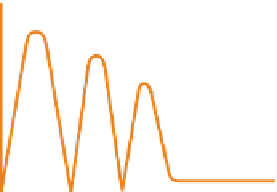Geoscience Reference
In-Depth Information
to the surface and then radiated or convected into the
atmosphere. Similarly, in the air, convection currents
may raise warm air masses to higher levels and then
conduction to the surrounding cooler atmosphere may
occur (see
Chapter 4),
while condensation of water vapour
releases latent heat. Convection is very important as an
energy transfer mechanism because it transfers energy in
two forms. The first is the sensible heat content of the air,
which is transferred directly by the rising and mixing of
warmed air. It can also be transferred by conduction. The
other form of energy transfer by convection is less
obvious, as there is no temperature change involved, hence
its name, latent heat.
Transfers also occur between other forms of energy. If
two objects with different kinetic energies are brought
together, a transfer takes place between the two which
tends to equalize the energy levels. For example, a rapidly
flowing stream (high kinetic energy) that comes into
contact with a static boulder (no kinetic energy) tends to
push the boulder into motion. In doing so, the stream
loses energy by friction but imparts some of this energy
to the boulder in the form of motion (kinetic energy).
Similar principles apply to chemical energy.
One way of looking at these transfers of energy is to
regard them as movements down an energy gradient. It
is easier to see this principle in the example of heat energy,
for we can all appreciate that heat moves from hotter to
cooler areas. Heat the end of a metal bar in a fire and the
heat will move along the metal until it burns your fingers!
Heat energy in this case moves down the energy gradient
in the bar. The same general processes operate with other
forms of energy (
Figure 2.5
)
High
potential energy
due to gravity
Energy transformations
During these transfers of energy it is clear that the nature
of the energy often changes, although the total quantity
of energy involved remains constant. Radiant energy heats
the objects it meets; it is converted from radiant energy
to heat energy. Kinetic energy may similarly be converted
to heat energy; the friction of a moving body against
another liberates heat, as we can demonstrate by filing or
sawing a piece of wood or metal.
Under natural conditions the range of probable
transformations is fairly limited. That is, the various forms
of energy are normally able to be converted to all other
forms, but follow relatively well defined pathways (
Figure
Low potential
energy
A bouncing ball starts with
high
kinetic energy
Stationary, it has
low kinetic energy
High
thermal energy
of cooking pot will transfer
to area of low thermal energy - your cooler hand
Solar energy is transmitted to Earth in the form of
radiant energy. How does this energy reach us? Why do
we receive the amount we do? Why does the energy have
the particular properties it has? To answer these questions
we need to examine some of the principles of radiation.
Radiant energy consists of electromagnetic waves of
varying length. Any object whose temperature is above
absolute zero
(0K or -273
C) emits radiant energy. The
intensity and the character of this radiation depend upon
the temperature of the emitting object. As the temperature
CH
4
(methane)
2O
2
(oxygen)
CO
2
(carbon dioxide)
2H
2
O
(water)
heat
High
chemical
energy
Low chemical
energy
Output of
energy









































































